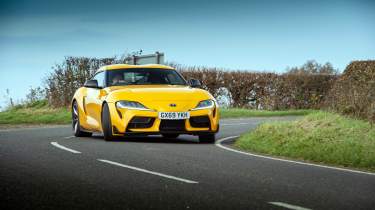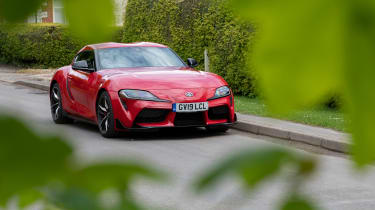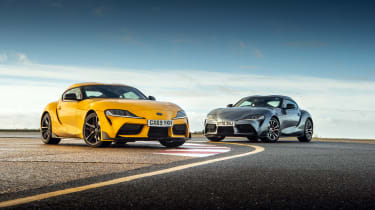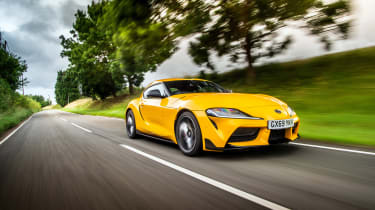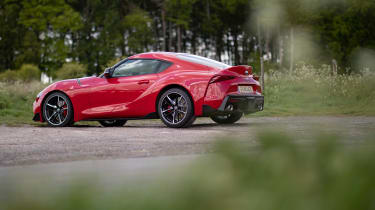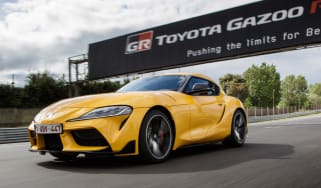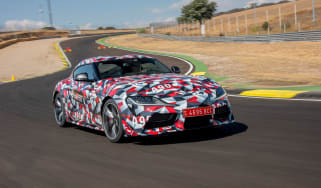Toyota GR Supra (A90, 2019 - 2024) review – did this reborn icon deserve the hate?
Toyota’s iconic coupe returned in 2019 but with German rather than Japanese bones. The grief it got as a result never went away, whether deserved or not…
The A90 Toyota Supra is no longer on sale in the UK, its short five-year tenure ending in 2024, with our shores denied the prospect of the tantalising, tarted-up 429bhp Final Edition. The A90 Supra didn’t have an easy time of it at any point throughout its life, its existence and the discourse around it seemingly haunted by its platform twin, the BMW Z4. Die-hard JDM fans and keyboard commentators couldn’t just be thankful that we had a Supra at all, instead consistently dismissing it as a Bavarian in a Japanese frock.
Was this dismissal reductive or deserved? evo has spent plenty of time in Supras of all flavours, from the first B58 six-cylinder cars, to the four-cylinder entry-level model, to the manual that promised to be the model’s saviour. Here’s our ultimate verdict.
Toyota GR Supra history
Like many high-performance Japanese cars, the A90 Supra’s journey from ideation to realisation began with a few false starts, before a long and drawn-out gestation gave an expectant market a car that struggled to live up to their expectations. Rumours of the Supra’s return were always humming in the background since the A80’s discontinuation in the 2000s.
They gathered steam with the FT-HS concept of 2007 (that car actually previewed what would become the GT86) and then reached critical mass with the introduction of the American Calty studio-designed FT-1. It was the themes (if not the lusty supercar proportions and astonishing interior) of the latter that would eventually be draped over BMW underpinnings to create the A90 Supra.
More reviews
Group tests
Long term tests
Reviews
We had good reason to be optimistic that the BMW/Toyota deal (hydrogen technology in exchange for a viable six-cylinder rear-drive sports car platform) would yield a car worthy of the Supra badge: torsionally stiffer than the Lexus LFA, with a lower centre of gravity than the GT86. The Supra got its own specification of springs, active dampers and anti-roll bars.
Toyota GR Supra: in detail
- Engine, gearbox and technical specs –Two BMW-sourced engines were available – a four and a six – with the latter eventually available with a manual gearbox
- Performance and 0-62 time – It did strong work with its relatively modest power figures, but both engines are at their best in the mid-range
- Ride and handling – Responsive, well balanced and grippy, with good traction in the dry and a decent ride, but on-the-limit handling can be indistinct
- MPG and running costs – Decent on-paper economy for its performance. Good warranty too.
- Interior and tech – A Toyota recipe with BMW ingredients. The outcome is a comfortable, well-judged environment, but small windows and dark trim leave it a bit gloomy
- Design – Traditional sports car proportions paired with unique design elements. It’s arguably the most distinctive part of the GR Supra.
None of it was enough to convince the naysayers in practice, with most complaining of a Germanic character to the engine, transmission, steering and, perhaps worst of all, the interior, which was the most obvious visual indication of its shared DNA, with a BMW steering wheel and digital user interface.
Toyota revised the GR Supra year over year, adding the 2-litre B48-engined car in 2021 (that actually turned out to have a nicer balance thanks to its lower weight) and the highly requested six-speed manual in 2022. The latter disappointed many again, with the transmission that Toyota claimed to be significantly revised compared to its application in BMWs feeling as rubbery and Germanic as if it hadn’t been touched. Special editions came and went – the Jarama and the Fuji Speedway editions to name just two – and the A90 even spawned a GT4 race car, but ultimately the model came and went without damaging the Porsche Cayman’s sports car market monopoly too heavily.
While our four-star rating indicates that the Supra is good, it’s also indicative of how it doesn’t offer any truly outstanding characteristics that elevate it into the realms of the very best. With hindsight, though, while we craved something with more edge, something more overtly Japanese, the A90 GR Supra wasn’t a bad car.
It wasn’t the most precise or scintillating sports car, it wasn’t an all-out tyre-shredding muscle car, it wasn’t a luxurious GT car, but it was a pleasing combination of all three and had its own unique place in a sports car market that, at the time, offered plenty of choice.
The GR Supra doesn't have the sparkling powertrain of the Porsche Cayman GTS 4.0, the agility of an Alpine A110, nor the balance of its smaller GR86 sibling, but there’s still plenty of appeal in this most distinctive of sports cars. All the same, by our reckoning, it was a car that was never allowed to reach and reveal its full potential.
Prices, specs and rivals
The Supra is now off-sale in the UK. When it was available, it was offered in a single Pro grade in both four- and six-cylinder forms. The base 2.0 Pro was £50,545, making it significantly more expensive than the GR86 (Toyota's smaller coupe, also now discontinued, that was priced at £32,495). The GR Supra 3.0 Pro cost £58,580, putting it right in the thick of rivals such as the Alpine A110 and Porsche 718 Cayman.
As mentioned above, Toyota gave the Supra a gentle set-up change later in its life, with a focus on improving precision by firming up the anti-roll bar bushings, recalibrating the adaptive dampers and rear differential, and amending the stability and traction control systems. The tweaks came alongside a new six-speed manual option that was only available on the 3.0 variant, with new forged 19-inch wheels thrown in for good measure.
All GR Supras got LED headlights, a limited-slip differential, a suite of safety systems, adaptive cruise and an 8.8-inch media screen. The 3.0 model, meanwhile, added a set of 19-inch wheels, a JBL stereo upgrade, a head-up display and wireless phone charging pad on top.
Two solid colours were offered (Lightning Yellow and Prominence Red, the latter for an extra £650), and it’s nice to see a manufacturer offering bright shades. Opting for metallic white, black, grey or blue adds £740 to the base price. A new beige interior colour option made from lighter seat fabrics also gave the interior a boost as part of the 2022 update.
Used Toyota Supra – prices and checkpoints
The earliest Toyota Supras from 2019 have now come down to the £30k mark and below, at least with a few miles on them. This kind of price, along with the peace of mind of the Toyota ownership and aftercare experience, should have many detractors reconsidering their stance on this controversial coupe. Now in its first few retirement years, a used-like-new Supra could be a great value sports coupe.
As a Japanese sports car, the Supra is a car you can expect to have been driven hard, so an immaculate service history should be a minimum requirement – especially as Toyota’s Relax scheme means that any Supra with a full dealer history can have its warranty extended beyond the standard three years, until the car is up to ten years old.
You’re going to want a car that’s got good life left in its tyres (both in terms of wear and age) and brakes. You’ll also want to be extra diligent in terms of looking for accident damage.
Toyota GR Supra specs
| Toyota GR Supra 2.0 | Toyota GR Supra 3.0 | Toyota GR Supra 3.0 manual | |
|---|---|---|---|
| Engine | In-line 4-cyl, 1998cc, turbo | In-line 6-cyl, 2998cc, turbocharged | In-line 6-cyl, 2998cc, turbocharged |
| Power | 254bhp @ 5000rpm | 335bhp @ 5000-6500rpm | 335bhp @ 5000-6500rpm |
| Torque | 295lb ft @ 1550-4400rpm | 369lb ft @ 1600-4500rpm | 369lb ft @ 1600-4500rpm |
| Weight | 1395kg | 1540kg | 1502kg |
| Power-to-weight | 185bhp/ton | 221bhp/ton | 227bhp/ton |
| 0-62mph | 5.2sec | 4.3sec | 4.6sec |
| Top speed | 155mph (limited) | 155mph (limited) | 155mph (limited |
| Basic price (new) | £46k+ | £55k+ | £55k+ |
